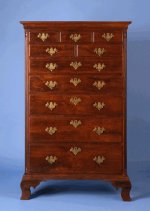You are using an out of date browser. It may not display this or other websites correctly.
You should upgrade or use an alternative browser.
You should upgrade or use an alternative browser.
How would the top of this chest been made...
- Thread starter ttalma
- Start date
Mark Arnold
Well-known member
The chest is 68" tall so I assume it would be visible
Tim,
You are, what, 6' 3"? 6' 4"? From the vantage point of an 18th century man, the top would probably not be seen.
Do you know if the sides are frame and panel? Or is the case dovetailed? There are probably a number of ways that this could be built so that the top is flush with the top of the molding.
Tim,
You are, what, 6' 3"? 6' 4"? From the vantage point of an 18th century man, the top would probably not be seen.
Do you know if the sides are frame and panel? Or is the case dovetailed? There are probably a number of ways that this could be built so that the top is flush with the top of the molding.
Jeff L Headley
Well-known member
Mark,
The sides would have been dovetailed into the top so you would not see the dovetails from the top. The mold on the sides would cover the dovetails. I have much more detail if you are intersted in the exceptional construction methods used in chests of this region. Great German influences, check out Kaare Loftheim's article in the new APF. Jeff
The sides would have been dovetailed into the top so you would not see the dovetails from the top. The mold on the sides would cover the dovetails. I have much more detail if you are intersted in the exceptional construction methods used in chests of this region. Great German influences, check out Kaare Loftheim's article in the new APF. Jeff
dkeller_nc
Well-known member
Hi Jeff - Would the original chest have used a secondary wood as the top? And would this be common on most flat-topped tall chests, chests-on-chests and other furniture of the period that would be too tall for the average person to see?
Jeff L Headley
Well-known member
As far as this chest I can not say. With many tall chests out of walnut you will see walnut used in the top. Walnut being so perevalent. Certainly not as nice as the front but you will also find many, if not most, with secondary tops. I would think with other primary woods, say cherry or maple you would find few using primary woods. With chest on chests primary woods on the top would be rare.
Share:

